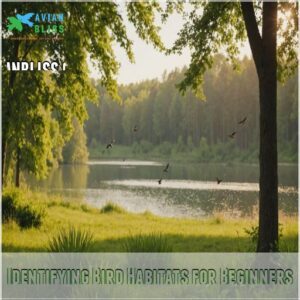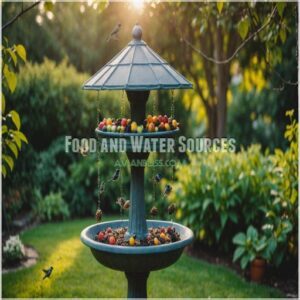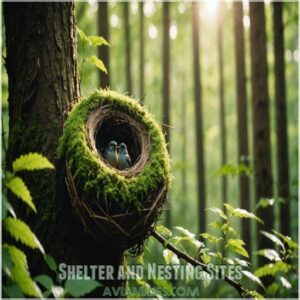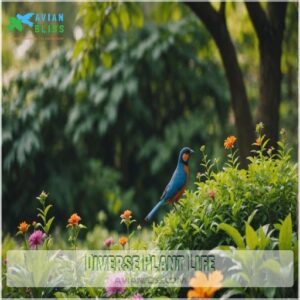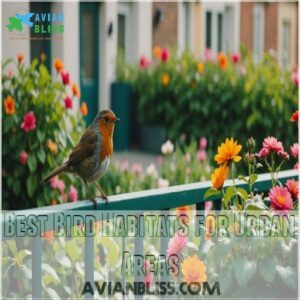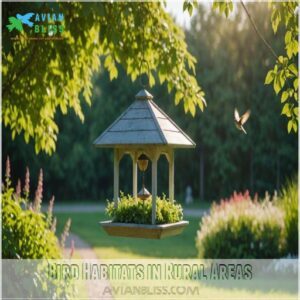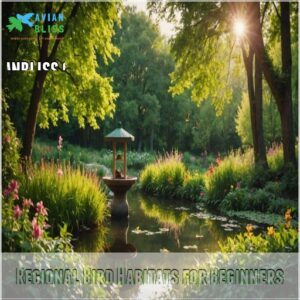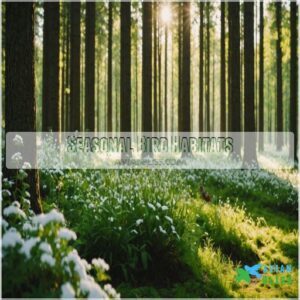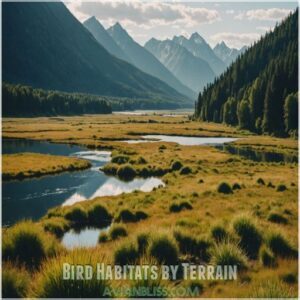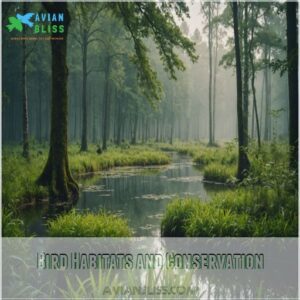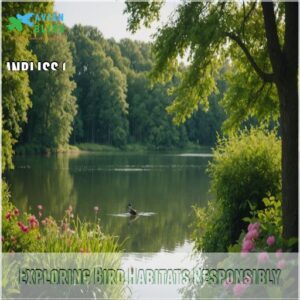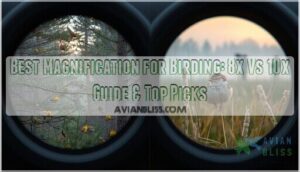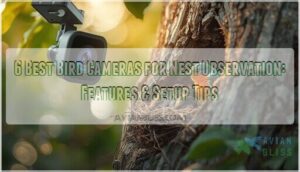This site is supported by our readers. We may earn a commission, at no cost to you, if you purchase through links.
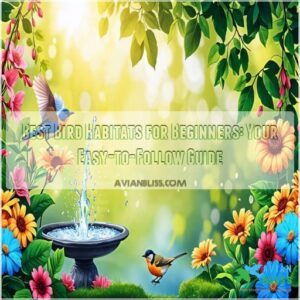 Looking for the best bird habitats for beginners? You’re in luck! Start with your own backyard – it’s like a treasure hunt in your PJs.
Looking for the best bird habitats for beginners? You’re in luck! Start with your own backyard – it’s like a treasure hunt in your PJs.
Local parks and wildlife refuges are goldmines too. They’re teeming with diverse plant life, offering a smorgasbord for our feathered friends.
Don’t forget water sources – birds love a good splash! City dwellers, fear not. Urban green spaces and community gardens are secret hotspots.
For a real adventure, explore nearby woodlands or wetlands. Remember, the best habitats provide the bird essentials: food, water, and shelter. It’s like a five-star hotel for birds! But wait, there’s more to discover about creating your own bird paradise…
Table Of Contents
- Key Takeaways
- Identifying Bird Habitats for Beginners
- Characteristics of Ideal Bird Habitats
- Best Bird Habitats for Urban Areas
- Bird Habitats in Rural Areas
- Creating a Bird-Friendly Habitat
- Regional Bird Habitats for Beginners
- Seasonal Bird Habitats
- Bird Habitats by Terrain
- Bird Habitats and Conservation
- Exploring Bird Habitats Responsibly
- Frequently Asked Questions (FAQs)
- Where can I find a good bird habitat?
- How to start birdwatching outside the backyard?
- Where should I start birding?
- How to start birdwatching for beginners?
- What is the best habitat for birds?
- What is the best bird for a first time bird owner?
- How to make a bird habitat in your backyard?
- What is the niche for a bird?
- What time of day is best for birdwatching?
- How close can I get to birds?
- Are there bird habitats to avoid as a beginner?
- Do I need special equipment for different habitats?
- How do weather conditions affect bird habitat activity?
- Conclusion
Key Takeaways
- You’ll find great beginner bird habitats right in your backyard, local parks, and wildlife refuges.
- Creating a bird-friendly environment involves providing food, water, shelter, and diverse native plants.
- Urban areas offer surprising birding opportunities in city parks, community gardens, and green spaces.
- You can explore different habitats responsibly by practicing good birdwatching etiquette and minimizing your environmental impact.
Identifying Bird Habitats for Beginners
When you’re just starting out with birdwatching, figuring out where birds hang out might seem like trying to solve a mystery, but it’s easier than you think.
With a little patience, you can spot these feathery friends in your own backyard, local parks, or nature preserves, and soon you’ll be the Sherlock Holmes of bird habitats!
Backyard Bird Habitats
Your backyard can be a haven for birds.
Start by adding native plants and you’ll see the magic unfold.
Here are quick birdwatching tips:
- Backyard bird feeders attract colorful guests.
- Bird baths bring invigorating splashes.
- Birdhouse placement provides cozy homes.
- Native plants provide food and shelter.
- Attracting songbirds enriches your soundscape.
Enjoy the diversity of backyard bird habitats!
Local Parks and Wildlife Refuges
Ready to move beyond your backyard?
Local parks and wildlife refuges offer fantastic birdwatching opportunities! They often boast diverse habitats.
Check out these great spots near you:
| Park Name | Features | Bird Species Seen | Accessibility | Park Conservation Efforts |
|---|---|---|---|---|
| Willow Creek Park | Ponds, wooded areas | Ducks, woodpeckers | Easy | Native plant restoration |
| City Green Sanctuary | Wetlands, tall grasses | Herons, sparrows | Moderate | Invasive species removal |
| Redwood Regional Park | Redwood forest, trails | Owls, warblers | Moderate | Trail maintenance |
| Eagle Lake Preserve | Lake, open fields | Eagles, geese | Easy | Water quality monitoring |
| Hidden Valley Park | Mixed forest, streams | Robins, bluebirds | Moderate | Habitat restoration |
Remember to respect wildlife and leave no trace!
Joining a local bird club enhances your experience.
Nature Preserves and Reserves
Nature’s many preserves and reserves are like birding havens just waiting for you!
Here, you’ll find bird sanctuaries bustling with local wildlife and endangered species.
Remember birdwatching etiquette: move quietly and respect preserve management efforts.
These areas are essential for conservation, offering safe havens for birds.
So, grab your binoculars and explore these bird reserves – unforgettable adventures await!
Characteristics of Ideal Bird Habitats
When you’re picking the perfect spot for birdwatching, think of a cozy cafe where birds can grab a bite, have a drink, and even settle down for a nap.
Ideal bird habitats offer food, water, shelter, and an array of diverse plants, making them the avian equivalent of a five-star hotel.
Food and Water Sources
Spotting birds in your backyard starts with understanding their buffet needs.
Bird feeders packed with diverse natural foods, such as sunflower seeds and suet, are a must, and learning how to attract birds to feeder can make a big difference.
Consider a backyard pond or a simple bird bath to keep their thirst quenched.
This bird-friendly habitat encourages bird feeding and backyard birdwatching while supporting bird conservation efforts.
It’s like running a cozy café for your feathered friends!
Shelter and Nesting Sites
Imagine this: you’re setting up a cozy bird haven in your garden, complete with tailor-made hideouts.
Birds love snug shelters and clever nest designs.
Consider adding a sturdy bird perch option to provide a safe landing spot.
- Cavity nests for species like bluebirds
- Nest boxes for safe bird lodging
- Predator protection strategies
- Reliable nesting materials like twigs
- Thoughtful nest site selection for peace
Birds will flock, and you’ll be the ultimate birdwatching host!
Diverse Plant Life
Imagine a garden where plants sway in a gentle breeze—ideal for attracting birds.
Diverse plant life, especially native plants, offers essential bird food sources and enriches habitat diversity.
Grab a field guide to hone your plant identification skills, and you’ll notice how bird species thrive around varied plant varieties.
Birdwatching tips: explore this vibrant world to uncover unique bird behaviors!
Best Bird Habitats for Urban Areas
You’d be surprised by how many bird species you can spot in urban areas like city parks, urban wildlife refuges, and community gardens.
Whether you’re wandering through green spaces or tending to your vegetable patch, you’ll find these spots perfect for your birdwatching adventures right in the middle of the city.
City Parks and Green Spaces
Surprisingly, city parks offer fantastic birdwatching opportunities!
You’ll often find a surprising bird diversity.
To maximize your urban birdwatching experience, remember these three things:
- Bring your binoculars for better bird identification.
- Check out areas with diverse plant life.
- Respect park rules and leave no trace.
Enjoy the show!
Urban Wildlife Refuges
City parks may offer a splash of green, but urban wildlife refuges are the heart of city bird diversity.
These havens pack urban refuge benefits like refuge management and easy access.
To better support these areas, consider learning more about protecting birds from common dangers like window collisions and outdoor cats.
Jump into bird identification here and tackle urban bird challenges with ease.
It’s birdwatching for beginners in the concrete jungle!
| Urban Refuge | Key Feature |
|---|---|
| Accessibility | Easy to reach |
| Bird Diversity | High species count |
| Management | Well-maintained |
| Challenges | Pollution threat |
| Hotspots | Rich bird areas |
Community Gardens
When your neighborhood’s bustling, sneak into a community garden—it’s a haven for birdwatching beginners.
These green gems shelter diverse bird species and attract pollinators.
Grab a field guide and spot everything from sparrows to warblers.
Meet local bird enthusiasts who use tools like bird identification by location to help with bird identification. Meet local bird guides happy to help with bird identification.
Tackle garden pest control naturally while connecting with neighbors through the joys of birdwatching and community outreach.
Bird Habitats in Rural Areas
In rural areas, you’ll discover that farmlands, forests, and wetlands offer rich habitats for a variety of birds.
Imagine spotting a heron gliding over a marsh or hearing the cheerful chatter of finches in a sunlit field—each landscape creates a unique birdwatching adventure just waiting for you.
Farmlands and Agricultural Areas
Let’s wander beyond city parks and explore farmlands—rich, open spaces perfect for birdwatching!
Imagine spotting a kestrel surfing the breeze above diverse crops.
These areas teem with life when bird-friendly farming practices and habitat restoration thrive.
Pesticide impacts are real, but crop diversity helps.
Grab your field guide, and if you’re on Long Island, the best time for spotting shorebirds is during their spring migration along the Atlantic Flyway. Watch bird migration, and get into bird identification adventures right here.
Woodlands and Forests
You’re probably curious if swapping fields for forests boosts your birdwatching game.
Imagine walking under canopy layers, greeted by the tweets of forest bird songs.
Woodlands offer rich experiences—think about the woodland ecology and bird migration routes you can explore.
Grab your field guide, learn bird species, and join in on forest conservation, making every trek an adventure.
Wetlands and Marshes
Exploring wetlands and marshes is like entering nature’s secret backstage.
Birdwatching here is a delight, with binoculars revealing hidden treasures.
You’ll find diverse bird species, each adapting to marsh plants’ vibrant diversity.
Notice their nesting habits—it’s like watching a family drama unfold.
So, explore these enchanting habitats for a fun, immersive experience, and maybe even pick up some wetland conservation pointers along the way!
Creating a Bird-Friendly Habitat
Want to turn your backyard into a feathered friend’s paradise?
You can easily create a bird-friendly habitat by providing food, water, shelter, and nesting sites – it’s like building a five-star hotel for your local avian population!
Planting Native Vegetation
After thinking about rural bird havens, let’s chat about planting native vegetation in your backyard.
It’s like giving birds a little oasis.
Imagine watching as they flock to your native masterpiece!
Here’s a quick guide:
- Choose local plants.
- Consider seed sourcing.
- Aim for habitat restoration.
- Visit local nurseries for expert advice.
Installing Bird Feeders and Baths
To create a bird-friendly habitat, consider combining a bird house with a feeder to provide an ideal environment with abundant food sources and nesting materials, as seen with a bird house with feeder combo, think about installing bird feeders and baths to attract feathered friends.
Pick from various bird feeder types that are compact and space-saving, such as those found in best bird feeders for apartments, and make sure you place them well.
Maintain your bird bath regularly so birds feel welcome.
Even a DIY bird bath can work wonders.
Whether you’re into birding for beginners or seasoned birdwatching, these tips can enrich your backyard.
Providing Nesting Boxes
Creating a cozy home for your feathered friends starts with nesting boxes. Here’s the scoop:
- Design and Materials: Choose durable materials and a design that suits specific bird species.
- Box Placement: Place boxes at safe heights, avoiding direct sunlight.
- Monitoring and Maintenance: Regularly check for occupants and maintain cleanliness.
Contribute to safe birdwatching and learn to identify different bird behaviors!
Regional Bird Habitats for Beginners
You’re about to discover some of the best regional bird habitats across North America and beyond, perfect for beginners.
Whether you’re wandering through Eastern woodlands, exploring Western mountain ranges, or adventuring in the lush environments of Central and South America, you’ll find a vibrant variety of birds waiting to make your acquaintance.
Eastern North America
Turning your yard into a bird haven might be fun, but let’s spread our wings and head to Eastern North America.
Here, you’ll find birdwatching hotspots teeming with songbirds and raptors.
Scan the skies during migration routes for a chance at unforgettable sightings.
Don’t forget your binoculars!
It’s birdwatching for beginners at its finest—just you, nature, and some fascinating feathery friends.
Western North America
Imagine this: you’re standing beneath a vast expanse of the Pacific coast, binoculars ready, spotting majestic California condors soaring over mountain habitats.
Western North America offers incredible birding hotspots, from desert birds in arid climates to spectacular migratory routes.
British Columbia boasts an array of backyard birds that include the Dark-eyed Junco and Song Sparrow.
Grab your field guides and set out on birding trips perfect for beginners.
Nature’s show awaits—truly a birdwatcher’s paradise!
Central and South America
Wow, Central and South America!
Think vibrant jungles and soaring Andean peaks.
You’ll find incredible Neotropical birds in the Amazon rainforest, Central American forests, and Caribbean islands.
Bird identification might be tricky, but birding tours can help.
These areas are birdwatching hotspots; prepare for amazing birdwatching experiences!
Seasonal Bird Habitats
To spot birds throughout the year, understanding seasonal habitats is key to good birdwatching.
You’ll find yourself following their journeys from spring migration marvels to summer breeding grounds, and if you’re lucky, you might even catch them during their fall migrations or winter retreats—it’s like binge-watching nature’s best documentary!
Spring Migration Patterns
Springtime’s like a bustling bird highway, as feathered travelers journey along fascinating migration routes.
You’re tracking these patterns not just for fun but to witness the incredible timing of nature itself.
Those first chirps might surprise you—who knew birds had schedules?
Grab a pair of binoculars and hit the birding hotspots, becoming part of this awe-inspiring research journey!
Summer Breeding Grounds
During summer, you’ll find vibrant breeding grounds buzzing with bird songs and nesting behaviors, as birds carefully choose nesting sites to avoid predators and harsh weather, often employing clever natural security systems. During summer, you’ll find vibrant breeding grounds buzzing with bird songs and nesting behaviors.
Ready to explore? Try these spots:
- Woodland Habitats: Perfect for spotting diverse species picking nesting sites.
- Wetlands: Great for observing successful bird breeding and migration patterns.
- Grasslands: Ideal for birding and learning about different bird identification techniques.
These areas are birding hotspots, offering safety and discovery.
Fall Migration Patterns
You saw birds raising their young all summer, didn’t you?
Now, as autumn whispers its cool secrets, those feathered friends set off on astonishing journeys.
Fall migration patterns are nature’s way of shaking things up.
| Aspect | Description |
|---|---|
| Fall Migration Routes | Paths birds follow southward |
| Birdwatching Hotspots | Best places to observe migrating birds |
| Weather Impact | How weather changes affect travels |
Explore these patterns and marvel at the majestic spectacle!
Wintering Grounds
When winter sneaks in, birds need cozy habitats with ample food sources like winter feeders.
Bird migration patterns change as climate change and habitat loss threaten their survival.
Identifying birds like brown birds with white spots, especially by their spot pattern and camouflage, can be a skill to develop, especially in birding hotspots. Spotting different bird species in wintering grounds can be a thrill, especially in birding hotspots.
So, grab those binoculars and get birdwatching; you’re in for an awe-inspiring time!
Bird Habitats by Terrain
You might think birds in coastal areas have it easy, lounging in perfect beachside villas, but each terrain shapes bird life in unique ways, like the distinct habitats of the wood stork vs roseate spoonbill wood stork vs roseate spoonbill.
Whether you’re exploring sandy shores, rocky mountains, or vast deserts, understanding these habitats will help you spot the most fascinating species and spruce up your birdwatching game.
Coastal and Beach Habitats
Now that we’ve looked at seasonal changes, let’s explore coastal areas! These dynamic habitats are fantastic for birdwatching. Grab your binoculars and field guides—you’ll spot amazing species.
- Shorebird migration is a spectacular sight.
- Beach nesting birds create fascinating nests.
- Coastal bird diversity is incredible; you might even see a rare seabird!
- Observing sandpiper behavior is endlessly entertaining.
Mountain and Hill Habitats
After experiencing the serene beaches, let’s ascend into mountain and hill habitats, where birdwatching becomes its own adventure sport.
Keep binoculars handy while hiking trails at various elevations to spot unique mountain bird species, such as the Mountain Chickadee’s coniferous habitats, where they often forage high in coniferous trees.
Notice how bird adaptations help them brave weather factors.
With a trusty field guide, identify bird behavior and enjoy the confidence that comes with knowing your avian neighbors.
Desert and Grassland Habitats
Imagine this: you’re in a vast desert or a rolling grassland, spotting desert birds with clever adaptations.
Water sources are scarce, so bring your binoculars and field guides to identify bird species efficiently.
Master their unique nesting strategies and learn about conservation efforts.
Birdwatching here isn’t just fun—it’s practically a little safari adventure that highlights nature’s resilience.
Bird Habitats and Conservation
You’ve probably noticed that protecting bird habitats isn’t just for the pros—it’s something you can get involved in right from your own backyard, and every little bit helps.
By taking simple steps to preserve natural areas and support sustainable practices, you’re giving our feathered friends a fighting chance, plus you get to be a hero without ever leaving home!
Protecting Endangered Species
In the varied landscapes of bird habitats, safeguarding endangered species demands attention.
To play your part in bird conservation, focus on these important steps:
- Create Safe Spaces in your garden for threatened birds.
- Join Local Conservation Groups, they’re great for support and socializing.
- Promote Wildlife Sanctuaries, as they help counter habitat loss and species decline.
Preserving Natural Habitats
Caring for bird habitats is like tending a shared garden.
By engaging in habitat restoration, you’re giving our feathered friends a home.
Ever noticed how sustainable farming helps too? It keeps landscapes bird-friendly.
Tackling invasive species control is essential as well; it’s all part of conservation efforts.
So, put on those birdwatching boots and explore birding hotspots with purpose and passion!
Supporting Sustainable Practices
Curious about supporting sustainable practices in bird conservation? It’s simpler than you think.
To nurture bird-friendly habitats, try these tips:
- Incorporate native plants to enhance bird-friendly landscaping.
- Engage in eco-tourism by visiting conservation areas.
- Use sustainable feeders for ethical birding.
- Follow birdwatching etiquette to respect local wildlife.
With these steps, you’re contributing to effective bird conservation!
Exploring Bird Habitats Responsibly
So you’ve found your perfect birding spot—fantastic!
Now, let’s make sure we explore it responsibly, keeping our impact light and leaving the habitat better than we found it, because happy birds mean happy birders.
Birdwatching Etiquette
While wandering through bird habitats, remember that birdwatching etiquette is a must.
Keep your footsteps light and your voice low—birds appreciate the peace! Always respect their space and don’t stray off trails, especially regarding responsible birding etiquette.
Binoculars are your best friend, helping you admire from afar without any drama.
By being a thoughtful birder, you’ll minimize your impact and guarantee a harmonious experience.
Respectful Bird Photography
You’ve mastered birdwatching etiquette, now let’s snap some stunning shots.
Respectful bird photography is an art. Use camera hides to blend in, and set up your tripod for crisp images.
Cut the flash to avoid startling our feathered friends.
For those National Geographic-worthy bird portraits, patience is your secret weapon.
Remember, you’re a guest in their home, so tread lightly and let the birds be your muse.
Minimizing Environmental Impact
Now that you’ve mastered the art of respectful bird photography, let’s talk about treading lightly in bird habitats.
As a green-thumbed birder, you’ll want to leave no trace and keep these feathered friends safe in their homes.
Here are some eco-friendly birding tips to help you become a true steward of nature:
- Stick to marked trails to avoid disturbing nesting areas
- Pack out what you pack in – leave no litter behind
- Use reusable water bottles and snack containers
- Opt for eco-friendly birding gear made from sustainable materials
Frequently Asked Questions (FAQs)
Where can I find a good bird habitat?
Like a treasure map for bird enthusiasts, your backyard’s a great starting point.
Local parks, lakes, and wildlife refuges offer diverse habitats.
Join a birding club to discover hidden gems.
Remember, the best habitat‘s where you’re comfortable and birds are plentiful, like a treasure map.
How to start birdwatching outside the backyard?
Ready to spread your wings?
Head to local parks, grab some binoculars, and join a birding club. They’re like treasure hunts for feathered friends.
Don’t forget a field guide—it’s your birding bible. Nature’s waiting, so let’s flock together!
Where should I start birding?
Backyard, park, or nearby lake – start where you’re comfortable.
You’ll find feathered friends in trees, on water, or at feeders.
Grab binoculars, a guide, and let nature’s symphony unfold. It’s a hoot, promise!
How to start birdwatching for beginners?
Grab a pair of binoculars and head to your backyard or local park.
You’ll be amazed at the feathered friends you’ll spot.
Start by learning common species, their calls, and behaviors. It’s a hoot, trust me!
What is the best habitat for birds?
Did you know 90% of birds thrive in diverse ecosystems?
You’ll spot the most birds in wetlands, forests, and meadows where food and shelter are abundant.
These natural habitats offer perfect viewing spots for nature’s winged wonders.
What is the best bird for a first time bird owner?
You’ll love a budgie as your first pet bird – they’re friendly, affordable, and easy to train.
These colorful companions are playful, can learn to talk, and typically live 7-15 years with proper care.
How to make a bird habitat in your backyard?
Create a welcoming backyard habitat by installing diverse bird feeders, native plants, and a water source.
They need to be kept clean, and it’s also important to maintain shelter options like birdhouses or dense shrubs for our feathered friends’ comfort and safety.
What is the niche for a bird?
Think of a bird’s niche as its one-of-a-kind lifestyle blueprint.
It’s where they hang out, what they munch on, and how they survive.
Every bird’s got their special role in nature’s grand theater.
What time of day is best for birdwatching?
Birds are most active during dawn’s first light and dusk’s golden hours.
You’ll spot the most feathered friends from sunrise to mid-morning, when they’re busy feeding and singing their hearts out.
How close can I get to birds?
You’ll want to maintain at least 20-30 feet distance from birds to avoid stressing them out. Use your binoculars for a close-up view while respecting their space and natural behaviors.
Are there bird habitats to avoid as a beginner?
As a beginner, it’s best to steer clear of dense forests or remote wetlands.
These habitats can be tricky to navigate and spot birds in.
Stick to open areas like parks or backyards where you’ll have better visibility and easier access.
Do I need special equipment for different habitats?
For most habitats, your basic gear will do the trick.
But if you’re venturing into wetlands, waterproof boots are a must.
Heading to dense forests? Pack insect repellent.
Remember, comfort’s key when you’re out birding!
How do weather conditions affect bird habitat activity?
Weather conditions play a big role in bird activity.
Rain can dampen spirits, but it’s a feast for worms!
Sunny days bring out the songbirds, while storms might’ve them hunkering down.
It’s like nature’s mood ring for our feathered friends.
Conclusion
Like a bird’s eye view of nature’s best spots, you’re now equipped to find the best bird habitats for beginners.
From your backyard to bustling urban parks, diverse landscapes await your discovery.
Remember, creating a bird-friendly environment is about more than just watching – it’s about fostering a connection with nature.
So grab your binoculars, pack some patience, and get ready to explore.
Who knows? You might just find yourself becoming the neighborhood’s go-to bird whisperer.
Happy birding!

